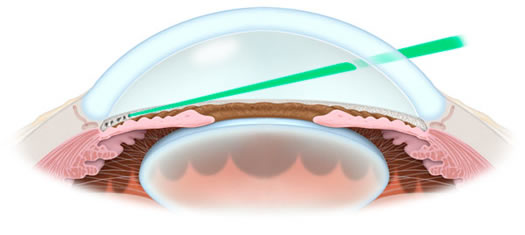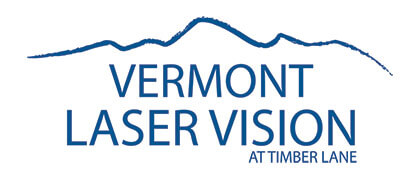Laser treatment of the drainage angle tissue can be a useful treatment for some types of open angle glaucoma.
Selective Laser Trabeculoplasty (SLT) is a clinically proven treatment that can help to lower the intraocular pressure (IOP). The SLT laser targets pigmented tissue calls within the drainage system of the eye with short, gentle bursts of light. The lowest possible laser energy is applied to cause the most minimal tissue response. Due to this there is little to no permanent visible change to the target tissue. These bursts of energy stimulate a natural healing response within the eye. As a result, the pores through which fluid must exit the eye become larger, causing a greater outflow of fluid, which in turn lowers the eye pressure.

SLT treatments are performed in the office through the same apparatus the doctor uses to examine patients. After the eye is numbed with drops, approximately 100 laser pulses are applied through a special mirrored lens. The procedure is not painful, but some patients report a slight pinch, soreness or burning sensation. Any discomfort is mild and usually tolerated without difficulty. While the treatment itself takes only a few minutes, the overall process takes approximately two hours due to preparatory and follow up measures to ensure the patient’s eyes are safe. Typically, only one eye is treated at a time The patient will continue all of their eye drops and will be given a prescription for an eye drop to be used only in the case that there is some discomfort after the procedure. The majority of patients do not feel there is a need for this medication.
Side effects after SLT laser treatments are rare. Below is a list of potential side effects:
- The most common side effects are mild and include soreness, redness and blurring of vision. There are usually very short-lived and can be treated easily and effectively with an eye drop.
- Elevated Eye Pressure- In some cases the eye pressure can increase after the procedure. This increase in eye pressure is usually temporary and may be treated with additional eye drops or oral medications. Very rarely this increase in eye pressure can persist and require more invasive surgical procedures to be performed.
- Peripheral Anterior Synechiae- Adhesion of the iris to the cornea.
- Inflammation and Swelling- In rare cases, SLT can lead to persistent inflammation within the eye. This is a potentially serious complication which can lead to other problems in the eye.
- It should be stressed that aside from the mild side effects described in the first bullet point, all of these are rare. In the unlikely case that these complications develop, the appropriate treatment will be administered.
For all medical procedures, the postoperative results vary amount individuals. There is the potential for SLT to not have any effect on the eye pressure. On the other hand, the effect can be marked and last for multiple years. Glaucoma drops may or may not be needed after the procedure depending on the individual circumstances. It is important to be continually monitored for glaucoma, so follow-up appointments are critical. If needed, SLT can be safely repeated in the future depending on results of previous applications.


